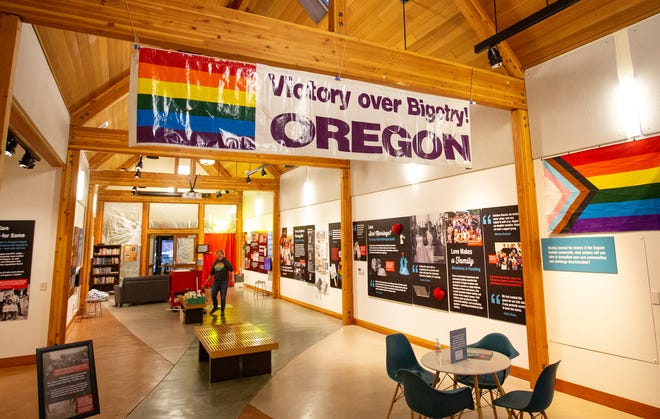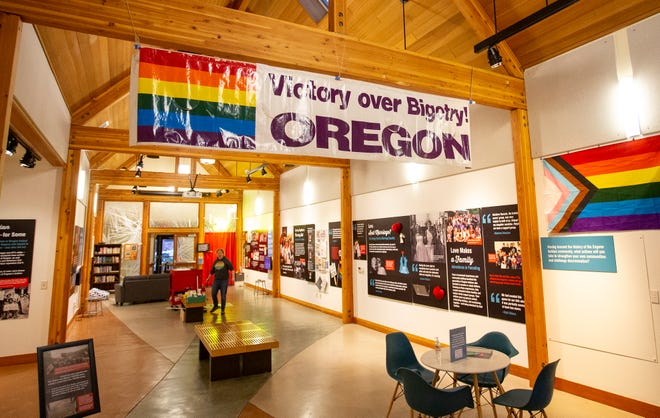
Through a new exhibit in the Museum of Natural and Cultural History at the University of Oregon, visitors can explore the rich and detailed history of the lesbian community in Eugene and the state of Oregon.
Eugene is known to be a hub for LGBTQ activism and inclusion, especially for lesbians.
Over the past four years, UO associate professor of Women’s, Gender, and Sexuality Studies Judith Raiskin and UO curator of manuscripts Linda Long collected images, symbols and stories on this history, speaking with 83 lesbians about their experiences living in Eugene.
Hundreds of hours of oral history have been consolidated into the exhibit Outliers & Outlaws: Stories from the Eugene Lesbian History Project. It will be open through the end of 2023 at the museum, 1680 E. 15th Ave.
The project is also published online at outliersoutlaws.uoregon.edu/.
The Register-Guard got an early viewing of the exhibit and compiled a few details to look out for while visiting the museum over the next year.
1. Eugene is a lesbian metro
Between the 1960s and 1990s, hundreds of young women who identified as lesbians came to Eugene seeking acceptance and community.
“Oregon was in many ways a test case for civil rights cases and queer rights,” Lexie Briggs, marketing and communications specialist for the museum, said. “It was because the community existed here in a way that it didn’t exist anywhere else.”
Many women were fleeing homophobic families and communities, looking for a home where they could explore their sexuality more comfortably.
2. UO students have been heavily involved
In 1969, UO students founded the Gay People’s Alliance. It was the first organization for gay men and lesbians at a West Coast university and was officially recognized by the university in 1973, one of few such organizations that received university funding.
Since then, the group has been active within the university and across the state, organizing Pride events and protests, and offering resources for LGBTQ students. It is now called the LGBTQA3 and continues to serve this student population.
For decades, UO has held Lavender Graduation for LGBTQ students, recognizing and celebrating their queer identities and sexualities.

3. Oregon has had a plethora of anti-LGBTQ legislation
Although Oregon is widely believed to have welcomed LGBTQ groups compared to other states, the community’s rights have been challenged throughout the decades.
In 1978, Referendum 51 overturned Eugene’s ordinance protecting gay men and lesbians from housing and employment discrimination. The referendum passed with 63% of voters in favor.
In 1988, Measure 8 overturned former Gov. Neil Goldschmidt’s executive order barring all state agencies from discriminating based on sexual orientation. The measure passed with 53% of voters in favor.
In 1992, Measure 9 would have amended the Oregon constitution to ban civil rights protection based on sexual orientation. However, the measure was rejected when 56% of voters voted against it.
Marriage between same-sex couples was fully legalized in Oregon on May 19, 2014, just over a year before the U.S. Supreme Court legalized it for the entire country.
4. Eugene’s lesbian-owned businesses
Several lesbian-owned businesses became prominent during this time, creating safe spaces for LGBTQ employees and customers.
When hundreds of lesbians migrated to Eugene, they sought not only a social community but also a professional one.

Examples include: Crescent Construction, the first all-women construction company in Oregon where each woman received equal pay; Jack Rabbit Press; Starflower Natural Foods Co-op; Amazon Kung Fu; Wow Hall; Tino’s Spaghetti House and Mother Kali’s Books.
Eugene is also home to several lesbian-specific arts groups such as Wallflower Order Dance Collective, Soromundi Lesbian Chorus and Women’s Press newspaper.
5. These are your neighbors
Most of the 83 people interviewed for this project still live in Eugene. They are friends, parents, grandparents, colleagues, siblings and community members.
“I think what will catch people’s eyes is going to be that they recognize these people,” Briggs said.
Bonus: The movement is ongoing
On Saturday, the musum will host a grand opening for the exhibit. The museum invited several LGBTQ groups that will be tabling at the museum from 10 a.m. to 3 p.m.
Local groups include Eugene Pride, Eugene School District 4J’s Gay Straight Alliance, Queer Eugene and TransPonder.
These groups continue to offer resources, support and advocacy for the local LGBTQ population.
There will be ongoing presentations at the new Outliers & Outlaws exhibit. Sunday, two of the lesbians interviewed for the project will give guided tours of the exhibit starting at noon.
The museum will host Thursday Night Talks to offer more about Eugene’s lesbian history from the women themselves. On Feb. 2, there will be a presentation on Eugene’s lesbian arts and culture scene from the 70s to the 90s. On March 9, there will be a presentation on lesbian businesses. Both will be held at the exhibit at 6 p.m.
“It’s just a really cool, cool story,” Briggs said. “I think you try to let their words speak for themselves.”
Miranda Cyr reports on education for The Register-Guard. You can contact her at mcyr@registerguard.com or find her on Twitter @mirandabcyr.








